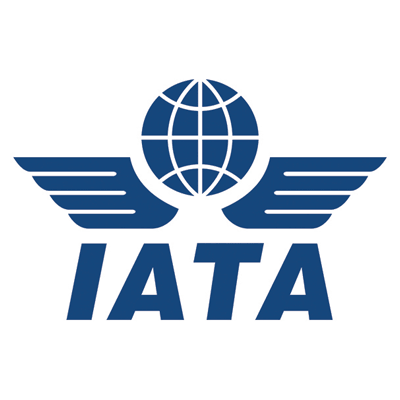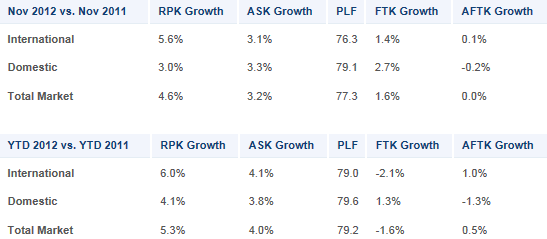Upswing in cargo brightens cautious demand outlook
- Like
- Digg
- Del
- Tumblr
- VKontakte
- Buffer
- Love This
- Odnoklassniki
- Meneame
- Blogger
- Amazon
- Yahoo Mail
- Gmail
- AOL
- Newsvine
- HackerNews
- Evernote
- MySpace
- Mail.ru
- Viadeo
- Line
- Comments
- Yummly
- SMS
- Viber
- Telegram
- Subscribe
- Skype
- Facebook Messenger
- Kakao
- LiveJournal
- Yammer
- Edgar
- Fintel
- Mix
- Instapaper
- Copy Link
Posted: 9 January 2013 | IATA | No comments yet
IATA released traffic results for November 2012 which showed an improvement in both passenger and air freight demand…


The International Air Transport Association (IATA) released traffic results for November 2012 which showed an improvement in both passenger and air freight demand. Air travel was 4.6% higher compared to November 2011, up on the October result of 2.9%. Air freight volumes edged up 1.6% over the same period after declining 2.6% in October, year to year. Passenger capacity rose 3.2% and load factor improved one percentage point to 77.3% compared to the year-ago period.
“November brought some positive signs for air transport demand—particularly for air cargo. It is premature to consider this a turning point for air cargo markets in terms of bouncing back and regaining lost ground. But, when coupled with positive economic developments in the US and an improvement in business confidence in recent months, the conditions are aligning to see a return to growth in 2013. In 2013 we expect that cargo volumes will grow 1.4%, and passenger traffic will increase by 4.5% worldwide,” said Tony Tyler, IATA’s Director General and CEO.
“Passenger markets have held up better than cargo in the face of adverse economic conditions. But the current level of air travel is just 2% higher than at the start of 2012. This is considerably weaker than the long-term average growth rate,” said Tyler.
Compared to October, November passenger traffic grew 0.6%. The majority of growth came from domestic markets, particularly China. November air freight volumes increased 2.4% on October. This reflects a shift in seasonal shopping to online retailers, which depend heavily on air cargo. It also shows improved consumer confidence in the US. Seasonally-adjusted air freight volumes have now risen back to the levels of mid-2012, after declines in the third quarter.


International Passenger Markets
November international passenger demand grew 5.6% compared to November 2011. However, the month-on-month increase was only 0.2%, indicating that year-on-year growth was more likely owing to depressed demand a year ago. Nevertheless, emerging markets in particular continued to perform well, and capacity increased 3.1% compared to a year ago. Load factor rose 1.8 percentage points to 76.3%.
- Asia-Pacific carriers experienced the strongest growth among the major regions, with demand up 6.2% year-on-year, on a capacity increase of 2.5%. Some of this growth, however, likely reflected depressed results in 2011 owing to flooding in Thailand. The growth of 1.7% in November compared to October could be due to volatility in the data given the extended period of slower growth since early 2012. Airlines in the region have experienced increased competition on long-haul markets, and continued improvement in the month-on-month growth would be needed to determine a change in trend. Load factor surged 2.6 percentage points to 75.7%.
- North American airlines’ demand was up 2.6% compared to November 2011, an improvement on the weak 0.2% growth in October, when Hurricane Sandy impacted international flights across the North Atlantic. Airlines in the region have experienced some of the slower growth rates in international traffic throughout the year, but that is largely a result of tight capacity management rather than particularly weak demand. Capacity climbed 0.4%, pushing load factor up 1.6 percentage points to 79.6%, the highest for any region.
- European carriers saw demand grow 4% compared to November 2011, while capacity climbed 0.8% and load factor was 77.8%, up 2.3 percentage points. Traffic rose 0.5% compared to October.
- Middle East airlines’ demand expanded 10.5% compared to November 2011, second best among the regions, continuing the exceptional growth throughout the year. However, this was outstripped by a capacity increase of 11.2% which resulted in the load factor falling 0.5 percentage points to 73.5%. Month-on-month growth was 0.3%.
- Latin American carriers posted demand growth of 11.0% compared to November 2011, the strongest of any region. Although the Latin American economy has suffered from the Eurozone crisis and China’s slower growth this year, strong domestic demand in several major economies has provided continued support to air travel. Capacity climbed 9.8% leading to an improvement in load factor of 0.8 percentage points to 76.3%. Compared to October, traffic rose 2.9%.
- African airlines saw demand expand 5.0% year-on-year but capacity growth was held in check, at 4.4%. Load factor rose 0.4 percentage points to 64.7% but remains the lowest of any region. Compared to October, African traffic was up just 0.1%.
Domestic Passenger Markets
Domestic markets rose 3.0% compared to November 2011, an improvement over the 2.4% year-on-year growth reported in October. However, the month-on-month increase was just 1.2%. Capacity growth of 3.3% outstripped demand and load factor dipped 0.2 percentage points to 79.1%.
- US demand travel was up 1.1%, but capacity expanded 2.7% leading to a 1.3 percentage point drop in load factor to a still industry-leading 82.1%. Demand rose just 0.6% compared to October.
- Chinese demand grew 7.7%, lagging strong capacity expansion of 10.3%. Load factor fell 1.9 percentage points to 79.1%. Compared to October Chinese domestic travel increased 1.9%.
- Indian demand fell by 6.5%, reflecting the slowing economy and sinking business confidence. Month-on-month traffic increased by 3.2%, the second month of positive growth in a row. However, it is not clear if India has turned the corner as business fundamentals remain weak.
- Japan traffic grew 4.4% year-on-year, eclipsing a 1.5% increase in capacity and pushing load factor up 1.9 percentage points to 67.3%–which was still the weakest for any market. Compared to October, demand rose 3%.
- Brazil recorded strong demand growth of 10.2%. Brazil has been the fastest-growing domestic market for two consecutive months. Capacity fell 2.1% and load factor jumped 8.3 percentage points to 73.9%. Compared to October, traffic rose 2.3%.
Freight Markets (International and Domestic)
Air freight markets rebounded strongly in November, expanding by 1.6% after a 2.6% year-on-year decline in October. Although some of this increase reflects the impact of the Thai floods in the year-ago period, the month-on-month increase of 2.4% is a positive sign.
- Asia-Pacific airlines were responsible for almost half the rise in total volumes compared to October. The 2.4% rise in month-on-month volumes for the region was in contrast to a 1.5% decline compared to November 2011. Freight capacity fell 2.8% over the period. North American carriers increased freight traffic by 1.7%, and cut capacity by 0.6%, compared to November 2011. European airlines’ year-on-year freight traffic was flat, and capacity grew just 0.3%.
- Middle East carriers’ freight showed the strongest year-on-year growth of any region, up 16% on just a 6.1% rise in capacity. Load factor surged to 46.7%, up 4 percentage points.
- Latin American airlines’ freight grew 4.2% year-on-year, but capacity grew at more than twice the rate, up 8.5%.
- African carriers grew freight volumes by 4.4% compared to November 2011. Although they kept the capacity increase to 3.6%, the load factor of 26.2% was still the weakest of all regions by a wide margin.
The Bottom Line
“The recently-ended holiday period serves as a reminder of the value aviation provides. Travel made possible by aviation brought seasonal goods to markets and re-united friends and families around the globe to celebrate.
2013 is the 100th year of commercial aviation. Over that century, through an ever-expanding network, air transport has transformed the way we live, work and play, providing jobs for some 57 million people and supporting $2.2 trillion in economic activity by connecting people and goods on 35,000 routes.
But continued connectivity growth is not guaranteed. The industry’s expected margin in 2013 of 1.3% is very weak. Furthermore current returns on investment are less than half the industry’s cost of capital, which continues to erode shareholder value.
In the New Year, governments should resolve to bring down the barriers to connectivity growth. This can be done by addressing excessive taxation, high infrastructure costs, onerous regulation and improving the capacity and efficiency of airports and air navigation services. A strong air transport sector is in the self-interest of governments eager to support economic growth and development. Trade is the key to growth. For that connectivity is critical. And it is aviation that makes connectivity happen,” said Tyler.
View November traffic results (pdf)













